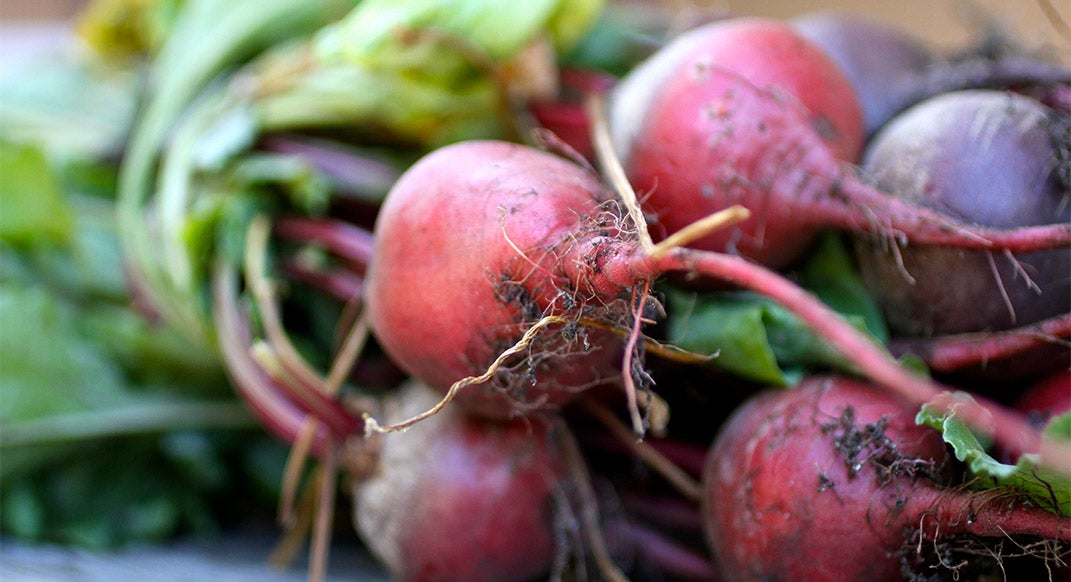Beet the Clock

Aside from their bright fuchsia hue and notoriously long cooking time, beets are one of the most undistinguished members of the vegetable family. They’re often overlooked in favor of potatoes or carrots, and have an off-putting tendency to turn salads—and even bowel movements—an interesting shade of purple. But maybe we’ve been writing beets off too long, without giving them the chance they deserve as both pre- and post-race nutrition for trail runners.
Why beets? Beets contain sodium nitrate and potassium nitrate, which, according to a study in the journal Sports, helps the body produce nitric oxide and increase muscle oxygenation and boost blood flow. Higher blood flow means more efficient muscle contractions, which translates into speed.
Indeed, research published in the Journal of Applied Physiology found that subjects who supplemented their diet with nitrate-rich beet juice exhibited a lower oxygen cost than subjects who didn’t drink beet juice. The beet drinkers also had a 15-percent increase in their time to exhaustion during high-intensity running tests.
Beet juice has long been a standby as a recovery drink thanks to its high antioxidant content. But many of the beneficial nutrients in beets—like nitrates, carotenoids and ascorbic acid—bind to fiber, which means that when the vegetable is broken down via juicing, those nutrients are no longer as easily absorbed by the body.
In other words: you’ll get a much higher nutrient kick from consuming whole beets, rather than just beet juice.
In Weiss’s own research, published in the Journal of the Academy of Nutrition and Dietetics, runners who ate whole beets had lower perceived effort during the second half of a 5K time-trial, and showed improvements of up to 23 seconds over previous, non-beet-fueled efforts.
Nitrate supplements can be just as effective, however it is easier to inadvertently take too much of a supplement. In the case of nitrates, this can cause nausea, difficulty breathing and dehydration. You’d have to eat a whole lot of beets to reach that point, which is why whole-food sources of nitrates are a wiser choice.
However, this doesn’t mean that you have to suddenly become a beet fanatic to reap the benefits of beets. In Weiss’s study, the 5Ks took place just 75 minutes after beet consumption, and participants still saw favorable results.
RELATED: A Runner’s Guide To Nitrate
Try It Out
With a little patience, beets are easy to cook and incorporate into a variety of meals. If the purple color is too much for you, opt for sunny and mild-flavored golden beets, which offer many of the same nutritional benefits. Roasted or boiled beets are easy to incorporate into a variety of recipes.
Roasted beets: To get started, scrub the roots and rub them with olive oil and wrap them tightly in tinfoil (since beets have a high sugar content, this protects your oven from drips). Roast at 400 degrees for 30 minutes, or until they give when you squeeze them.
Boiled beets: Wash the beets and boil them until you can pierce them with a fork, then slide the skins off.
Purple Power Smoothie
This portable breakfast or post-workout snack packs protein and antioxidants from blueberries and pomegranates along with all the goodness of beets.
1 boiled beet, skin removed
1 cup blueberries
1/2 cup of your favorite yogurt
1/4 cup pomegranate juice
1/2 cup milk
Chop the beet into chunks and puree in a blender along with the blueberries. Add yogurt, pomegranate juice and milk and puree until smooth, adding more milk or yogurt to reach desired thickness.
RELATED: 8 Muscle-Building Veggies To Boost Your Strength
Beet Hummus
1 large roasted beet, skin removed
1 – 14 oz. can chickpeas, drained and rinsed
3 cloves garlic, minced fine
1/4 cup tahini (sesame seed paste)
1/4 cup olive oil
Salt and pepper
Puree roasted beet with chickpeas and garlic until smooth, scraping down the blender as you go. Add tahini and enough olive oil, adding more oil as needed to make it spreadable. Finish with salt and pepper and use as a spread for sandwiches or a dip for veggies or pita chips.
RELATED: Deena Kastor Shares Her Favorite Juice Recipes
Flourless Chocolate Beet Cake
Yep, you read that right. Beets add moisture to this dense cake, and you won’t even know they’re there.
2 medium raw beets, scrubbed and peeled (a potato peeler works well)
1 cup sugar
4 eggs
3/4 cup (1 1/2 sticks) unsalted butter, melted
1 t vanilla extract
1/2 cup cocoa powder
1 t salt
Preheat oven to 350 degrees.
Grate raw beets on a box grater or in a food processor. Add 1 cup water and boil until beets are soft. Puree shredded beets and 1/2 cup water until smooth. Set aside.
Whisk sugar, eggs and melted butter until smooth. Add beet puree, vanilla extract, cocoa powder and salt.
Bake in a greased 8×8-inch pan until a toothpick inserted in the center comes out clean, 30-40 minutes.
Optional: Melt 8 oz. bittersweet chocolate with 3 T butter in a small saucepan or double boiler. Pour over cooled cake and let set before slicing.